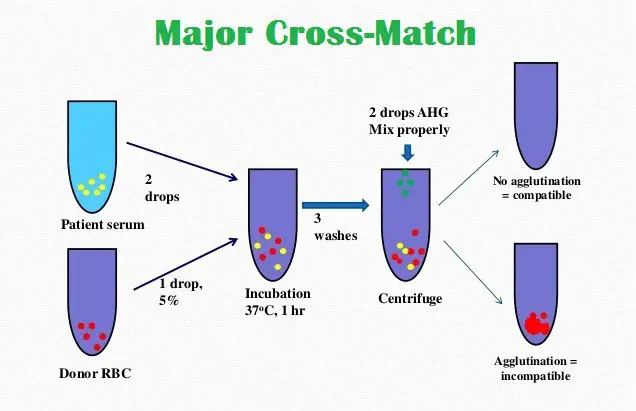Cross Matching is a procedure performed prior to a blood transfusion to determine whether donor blood is compatible (or incompatible) with recipient blood.
Compatibility is determined through matching of different blood group systems, the most important of which are the ABO and Rh system, and/or by directly testing for the presence of antibodies against a sample of donor tissues or blood.
Purpose of Cross Matching
The crossmatch is routinely used as the final step of pretransfusion compatibility testing. The purposes of compatibility testing are to detect: irregular antibodies; errors in ABO grouping, and clerical errors in patient identification and result recording.
The crossmatch will detect the following:
1. Most recipient antibodies directed against antigens on the donor red blood cells.
2. Major errors in ABO grouping, labeling, and identification of donors and recipients.
Principle
Cross-matching will detect incompatibilities between the donor and recipient that will not be evident on blood typing. There are two types of cross-matches: Major cross-match and Minor cross-match.
The major crossmatch involves testing the patient’s serum with donor cells to determine whether the patient has an antibody which may cause a hemolytic transfusion reaction or decreased cell survival of donor cells. This is the most important cross-match.
The minor crossmatch involves testing the patients cells with donor plasma to determine whether there is an antibody in the donor’s plasma directed against an antigen on the patient’s cells.
Procedure
- Prepare donor and recipient blood samples:
For Major crossmatch : Donor’s red cell and recipient serum or plasma
For Minor crossmatch : Recipient red cells and donor’s serum or plasma - Prepare 3 – 5% cell suspensions of red cells.
- Major Crossmatch:
Label a test tube. Add two drops of the patient serum and one drop of the appropriate donor cell suspension. - Minor Crossmatch:
Label a test tube. Add two drops of the appropriate donor serum and one drop of the patient cell suspension. - Mix the tubes and incubate at 37°C for about 45 minutes.
- Add two drops of AHG (Antihuman globulin) and mix well.
- Centrifuge for 1 minute at 1500 rpm
- Read macroscopically and microscopically and record the results
Interpretation
The mixture of erythrocytes and serum are observed for hemolysis or microscopically for agglutination. Any evidence of hemolysis/agglutination indicates an incompatible cross-match. Negative results are taken to indicate compatibility.


thankx
thx
bro I need more information abt laboratories
thank you..
Thanks alot
Appreciated
good
i like it
good presentation
Good,
simple and precise
Appreciated
Thanks for the presentation
Thanks.thi preparation is helpful so thanks again
HI
do you work in blood bank?
also wrrte the phase of cross match its more better..thnks
A very nice presentation BMLS student
BUK Nigeria appreciate.Thank you
Thanks A lot… It is Quite a Lesson
..
It is very nice presentation
Thank u
thank you
it very nice presentation
Thank you for the information
well n precious but is it possible to us doner’s red cells against recipaint’s serum or plasma
well described
simple and understandable
Laboratory tests are explained in a very simple language. very beneficial. thanks
It helped me a lot
Very simple to understand..thank you
Thank you
Simply understand
Please if any new information about blood transfusion share
Thank you for this knowledge…..
great presentation bro. cheers. Kenyan athlete and scholarship student in medical laboratory science research.
thanks
Thank you so much for the information
Zambian student of biomedical science
Thanks